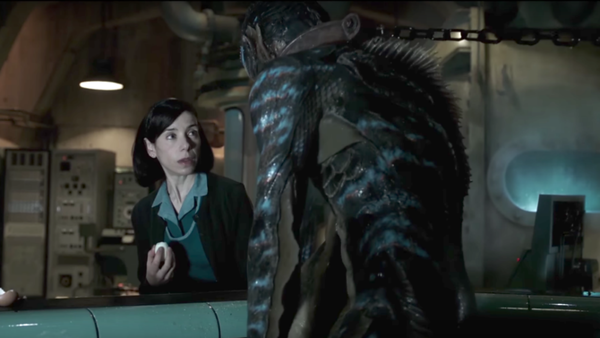Review: The Shape of Water

WSPN’s Emma Nallet provides her opinion on Guillermo Del Toro’s “The Shape of Water.”
January 26, 2018
Warning: this article contains some considerable spoilers.
“The Shape of Water” breathes life into Guillermo Del Toro’s cinema, with its poignant romance, its increasing thrill and its persistent questioning of perspective. At first sight, this new film seems to be a classical tale. But don’t be mistaken. After two productions that left us dissatisfied (“Pacific Rim” and “Crimson Peaks”), Del Toro comes back in force with this new movie by fully developing the characters without neglecting the beauty of images.
Throughout this epic fable, sensibility and fantasy mingle with verve, stemming straight from the director’s imagination and works that filled his childhood. More than a childish fairy tale, this film is more like “Creature From the Black Lagoon,” the classic monster movie. In fact, both films take place in the midst of the Cold War and depict the discovery of an aquatic creature in the Amazonian rainforest that then exacerbates the best and the worst human behavior.
“The Shape of Water” narrates the story of Elisa, a humble cleaner for a high-security governmental laboratory based in Baltimore, beautifully personified by Sally Hawkins. The first scene focuses on the dull daily life of the young woman, who at first glance is gentle and self-effacing, but nevertheless fascinating. When she is in charge of cleaning an experiment room bathed in blood, she makes the fortuitous and forbidden acquaintance of a fantastic half-human, half-amphibian creature. Elisa, who became mute after mutilations while she was an infant, immediately creates a strong connection with this bizarre humanoid (played by Doug Jones) from the Amazonian lands, who can’t communicate just like her. However, the unforeseen chemistry that arises between her and this swamp man who is fond of jazz music and hard-boiled eggs soon provokes the rage of special agent Richard Strickland, the creature’s torturer.
At first glance, “The Shape of Water” embodies the perfect romance, resembling another “Princess and the Frog” story. However, behind the fairytale for adults appears a film with an aura shrewdly political and philosophical. Through this improbable love, Del Toro questions what makes us human. Del Toro’s counterpoint to the love relationship is the frantic and despotic agent Strickland. Portrayed by Michael Shannon, Strickland illustrates a man with a derisory manliness, living with his wife and his two children in a wealthy neighborhood. He flirts with sexual harassment while loving his Cadillac and the book “The Power of Positive Thinking.” In other words, he’s the perfect archetype of the 1960’s man. The marine human, whose name is never revealed, is a victim of Strickland’s daily violence. The one who is assumed to be a merciless monster dazzles with his humanity, whereas the one with a definite human body, unveils a hideous and grotesque face.
“The Shape of Water” also destroys the gender stereotypes by mocking Strickland’s masculinity and demonstrating the power of human bonds over an authoritarian will. That is why Elisa risks her life to save her soulmate’s life, helped by her friend and workmate Zelda (Octavia Spencer), an iron-willed African-American woman, her gay and fanciful neighbor (Richard Jenkins), as well as an undercover Russian scientist. In this new movie, Del Toro depicts a plural and eclectic America made up of minorities that are each in their way marginalized. It’s a picture that resembles the contemporary United States: a society of consumption that Del Toro shows in its absurdity, and portrays it as the antipode of love, a stress exacerbator.
In general, “The Shape of Water” is a success. Even if the message is sometimes too evident, some scenes are cheesy and the romance is a bit too overrated, one must still recognize the quality of Del Toro’s framing. The fluidity of the back and forth of the camera and the way it increases the tension or instills a shred of irony deserves some consideration, without forgetting Hawkins’s great performance as she manages to express the power of her love in a forced silence. Although Del Toro doesn’t reach the splendor of “Pan’s Labyrinth” (2006), he still renders a moving film and one of his most beautiful cinematographic works.
Rating: 8.5/10
Opinion articles written by staff members represent their personal views. The opinions expressed do not necessarily represent WSPN as a publication.





![Last Wednesday, the Wayland School Committee gathered to discuss a number of topics regarding the health curriculum and Innovation Career Pathway course. Another large topic of conversation was the ways to potentially mitigate distracting cell phone usage. "These [phones] are going to distract your learning and social relationships," Superintendent David Fleishman said. "That's concrete right there."](https://waylandstudentpress.com/wp-content/uploads/2025/06/Screenshot-2025-06-04-at-9.49.31 PM-1200x886.png)



























![Troy Hoyt finishes the Boston Marathon, running for the Hoyt Foundation. T. Hoyt is the son of Hoyt Foundation CEO Russ Hoyt.
“[Running a marathon] might seem like a big thing, when it’s presented to you at first, but if you break it up and just keep telling yourself, “Yes, you can,” you can start chipping away at it. And before you know it, you’ll be running the whole 26 miles, and you won’t even think twice about it.” T. Hoyt said.](https://waylandstudentpress.com/wp-content/uploads/2025/04/C36E8761-1CBB-452E-9DF2-543EF7B1095E_1_105_c.jpeg)












































